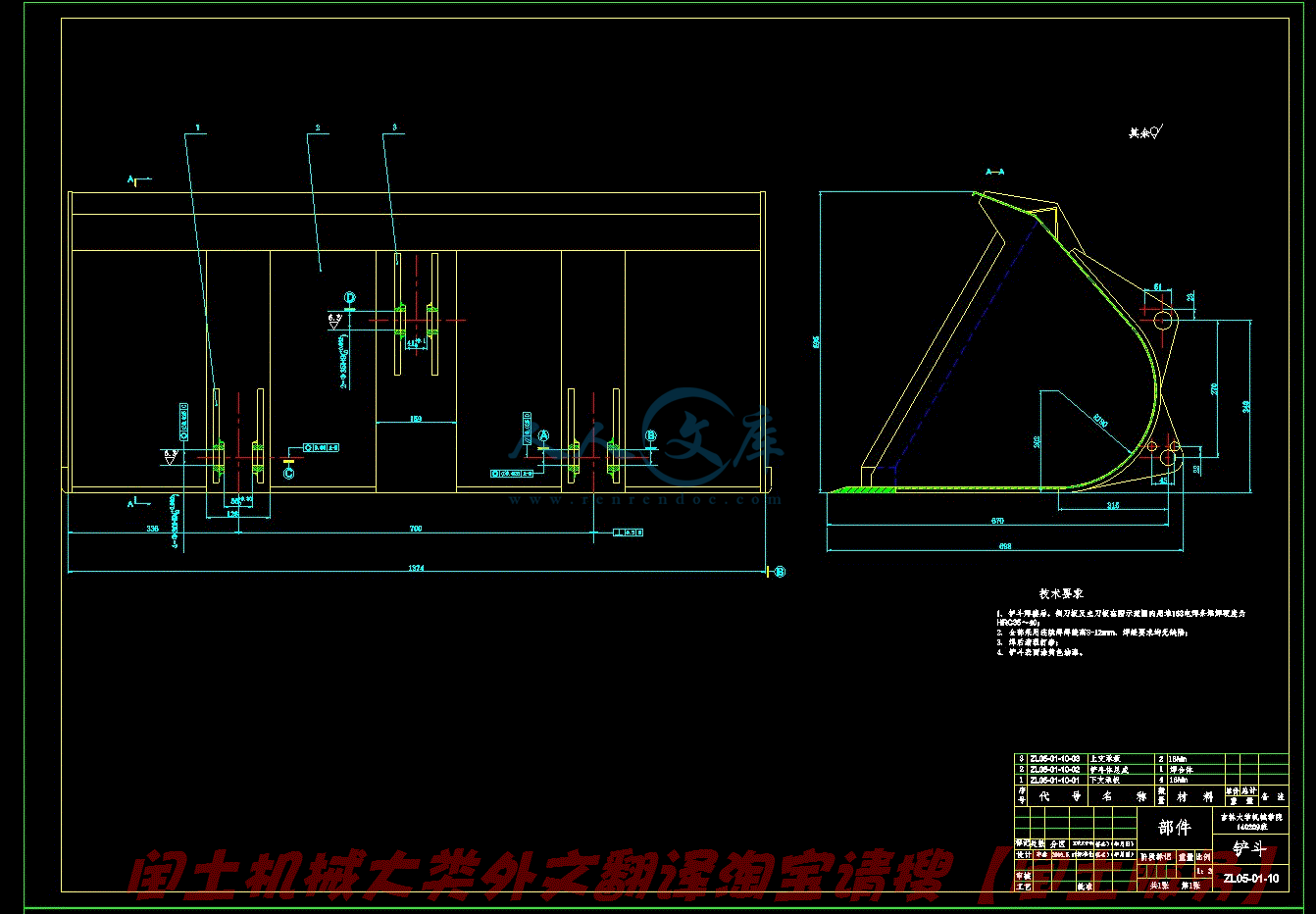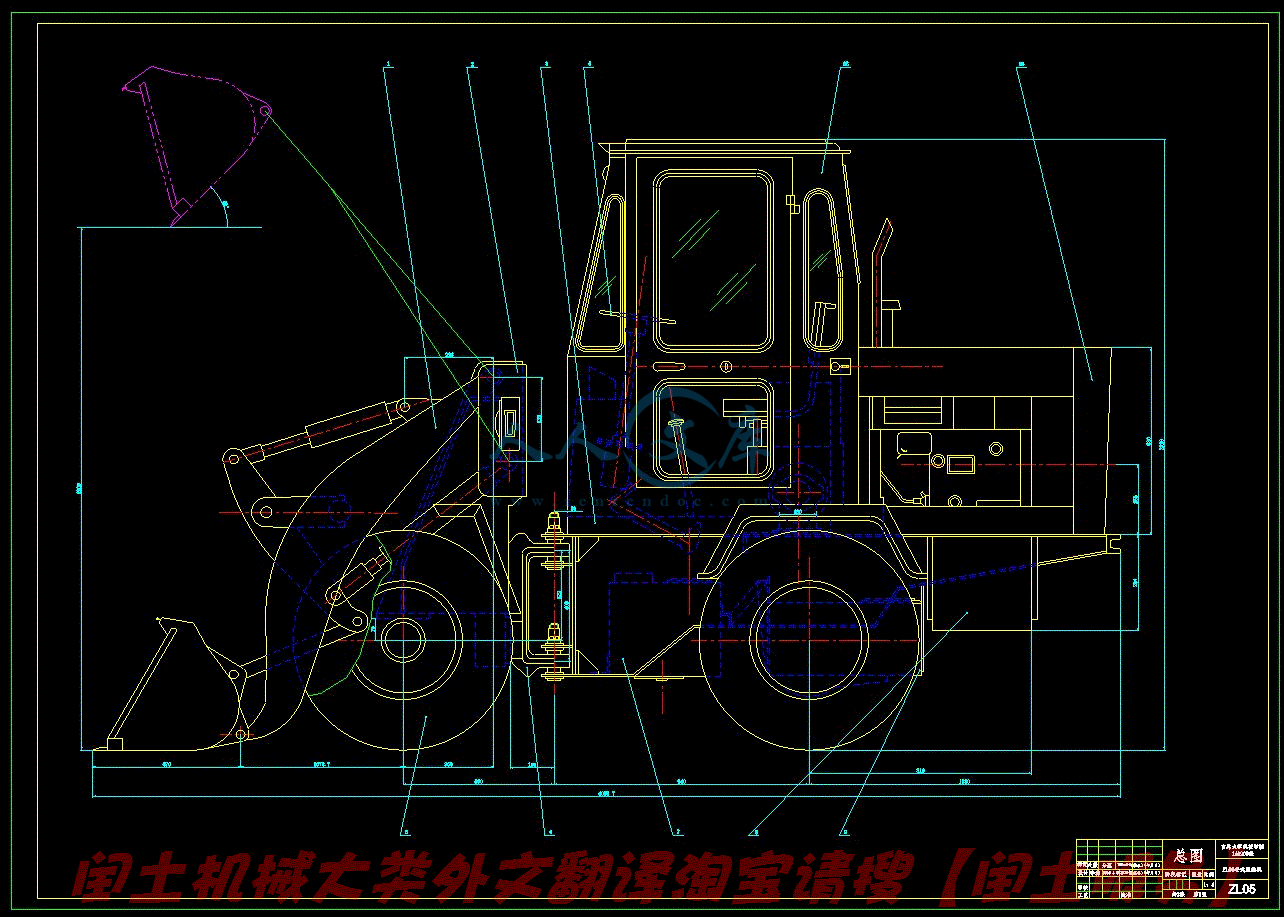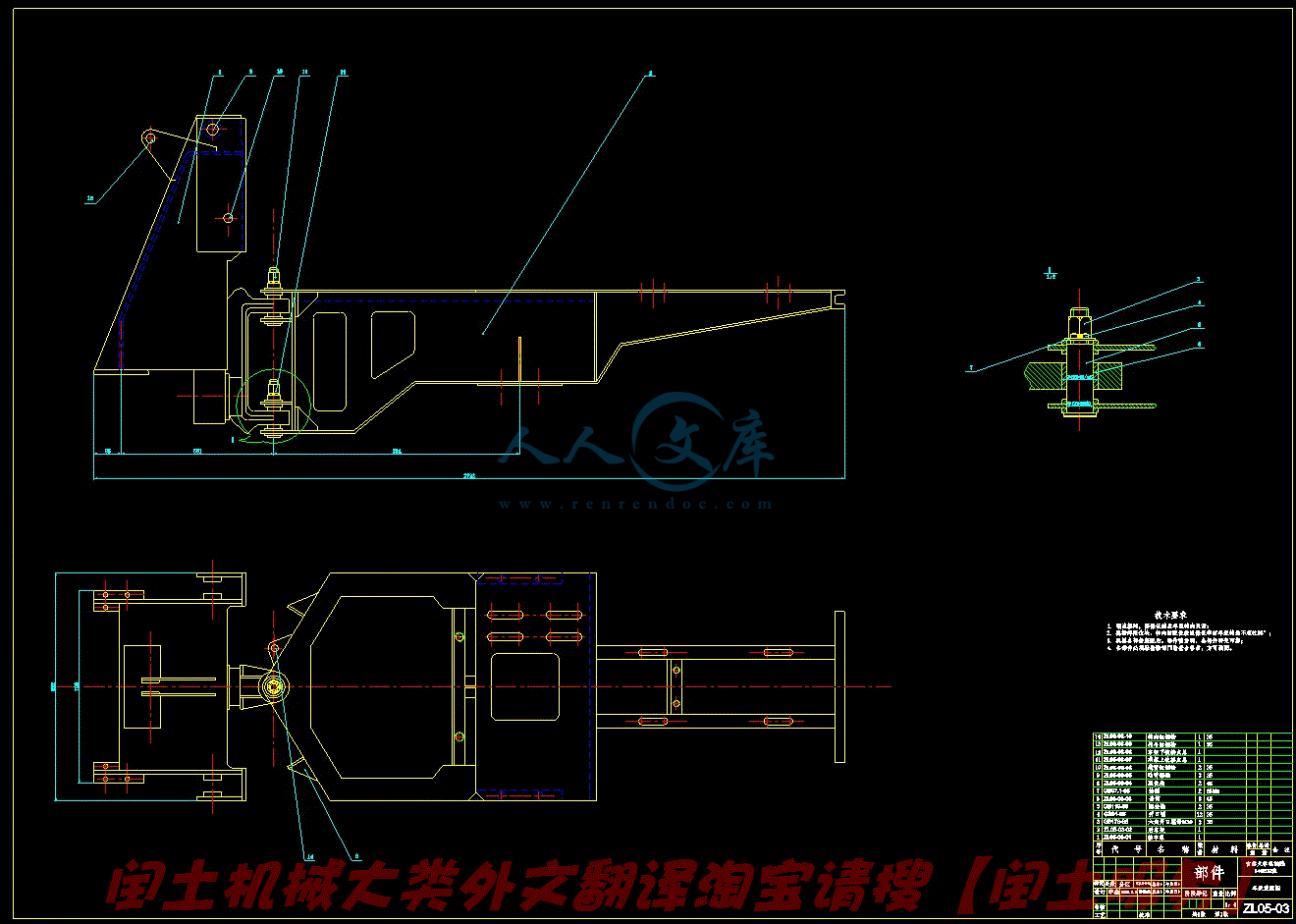资源目录

压缩包内文档预览:
编号:6035139
类型:共享资源
大小:5.29MB
格式:RAR
上传时间:2017-10-23
上传人:闰***
认证信息
个人认证
冯**(实名认证)
河南
IP属地:河南
50
积分
- 关 键 词:
-
zl05
微型
轮式
装载机
总体设计
- 资源描述:
-






- 内容简介:
-
本科生毕业设计(论文)翻译资料英文题目:Aspects to improve cabin comfort of wheel loaders and excavators accord- ing to operators中文题目:改变轮式装载机和挖掘机机舱里操作者舒适性的方面的内容 学生姓名:李鑫 学 号:14020926 班 级:140209 专 业:机械工程及自动化 指导教师:李 风 1Aspects to improve cabin comfort of wheel loaders and excavators according to operatorsAbstractComfort plays an increasingly important role in interior design of earth moving equipment. Although research has been conducted on vehicle interiors of wheel loa- ders and excavators, hardly any information is known about the operators opinion. In this study a questionnaire was completed by machine operators to get their opinion about aspects which need to be improved in order to design a more comfortable vehi- cle interior. The results show that almost half of the operators rate the comfort of th- eir cabin“average” or “poor”. According to the operators, cab comfort of wheel loaders can be increased by improving seat comfort. Besides improving seat comfort, cabin comfort of excavators can be improved by changing the cab design (including dimensions, ingress/egress), view, reliability, and climate control.Keywords: Cabin comfort; Operators opinion; Earth moving equipment.1. IntroductionComfort plays an increasingly important role in vehicle design. As machine operators of earth moving equipment often spend long hours in their vehicle some- times even more than 8 h a daycomfort is a major issue in interior design of these machines.Operating earth-moving machinery is not a physically heavy job and can be sustained for long periods.Nevertheless, operating such a machine appears to be a risk factor for musculoskeletal disorders, especially when the task is not interrupted by other working activities or breaks. Zimmerman et al. (1997) showed that the main problems of earth-moving machinery operators concern physical complaints in the neck/ shoulder and low back region, general fatigue and feelings of discomfort. This might be attributed to a combination of static load during prolonged sitting frequ- ently in awkward posturesexposure to whole body vibrations, and handling and steering the machine(Zimmerman et al., 1997; Tola et al., 1988; de Looze et al., 22000).A comfortable well-designed vehicle interior may reduce awkward postures and provide an environment that stimulates optimal operator performance. Based on a literature review about musculoskeletal disorders and their risk factors, Zimmerman et al. (1997) made four recommendations for reducing work-related musculoskeletal disorders among operators: minimizing of magnitude and frequency of vibration rea- ching the operator; locating controls optimally to minimize reach distances, trunk exion and trunk rotation; providing maximum operator visibility from an upright supported seated posture; and taking regular breaks to minimize the effects of sus- tained postures. Improvements of cab comfort are very often based on reducing the risk factors for work-related musculoskeletal disorders (Zimmerman et al., 1997; Attebrant et al., 1997). Only a few studies have mentioned aspects which operators wishto see improved. Nakada (1997) describes the desirability ranking for dump trucks and wheel loaders given by product creators, designers, design engineers, operators and young people. Nakada, (1997) shows that much design attention has been paid to instrument panel/monitors and meters and the operator seat. Unfor- tunately, the operators opinions cannot be distinguished in Nakadas study (1997).However, in order to design a comfortable vehicle interior, the opinion of the operators is important as they are the end-users of the machines. Their user expe- rience may be of great help designing a more comfortable vehicle interior. The aim of the current study is to nd aspects mentioned by wheel loader and excavator ope- rators, which can be used to improve the comfort of vehicle interiors in the future. In this article we describe the results of a questionnaire given to 273 machine operators. They were asked their opinion about their current machine, their future demands and aspects they considered important to work well with the machine. This allowed us to identify aspects that need improvement in machine design.2. Method2.1. SubjectsA convenience sample was obtained through approaching operators visiting Ba- 3uma (the worlds largest exhibition for construction equipment). Most of the parti- cipants were wheel loader operators (n = 61) and excavator operators (n=212). The others (n = 65) were operators of several construction machines (e.g., mobile cranes, dozers, tower cranes, off-road trucks). Only the results for wheel loader and excava- tor operators are presented in this article, as they account for 18% and 62.7% of the total number of respondents respectively. Figs. 1 and 2 show a typical wheel loader and excavator.2.2. QuestionnaireData were collected by means of a questionnaire which was completed during an interview. The questionnaire was divided into three parts: (1) characteristics of the population, (2) evaluation of the current machine being operated, and (3) future de- mands on earthmoving machinery. In the rst part we asked the operators age, years of experience as operator, the kind of machinery being operated and its age. In the se- cond part of the questionnaire, operators evaluated their machine by rating overall comfort and their opinion of specic parts of the machine on a four-point scale (very good, good, average, poor). Finally, two open questions asked about the operators f- uture demands: what improvements would make the machine more comfortable and what aspects are the most important to work well with the machine.42.3. Data analysisData were sorted by machine type, after which the responses of wheel loader operators and excavator operators were separately analyzed. Within these groups, operators of older machinery (4 years old) were separated from operators of newer machinery ( 4 years old). In addition, the categories very good andgood were combined (very good/good) and the categories average and poor were com- bined(average/poor).Frequency tables were made of the operators opinions about overall machine comfort and about their opinions about specic parts of their machines. Chi-square was calculated between age of machine and overall comfort and between age of ma- chine and the operators opinion of specic parts of the machine. We assumed that if fewer than 80% of the operators rated a part of the machine good/very good, im- provement of this part could contribute to a more comfortable vehicle interior. In part three of the questionnaire, the operators indicated aspects to improve machine com- fort and aspects they found necessary to work well with the machine. We classied 5these aspects into categories and calculated the percentage responses.3. Results3.1. Characteristics of the populationBoth the wheel loader operators (mean age: 36.59.4 years) and the excavator operators (mean age: 36.39.3 years) who participated in this study, were experien- ced with a mean of 12.3 (8.1) and 13.4 (9.2) years of service, respectively. Half of the operators operate machines less than 4 years old (53% of the wheel loader and 50% of the excavator operators).3.2. Evaluation of current machine57.4% of wheel loader operators and 55.9% of the excavator operators rated the overall cabin comfortgood/very good. It shows that operators of newer machinery (4 years old) rated the overall cab comfort as good/very good more often than operators of older machines (4 years old). This was found both among wheel load- ers (2(1)=8.5,p0.04) and among excavators (2(1)=23.0,p0.001).Seventy-eight percent of the operators driving wheel loaders less than 4 years old, rated the comfort of their machine as good/very good.With excavator operators this gure was 81%. These results show that during recent years the experienced cab comfort of excavat- ors and wheel loaders has improved.It illustrates the opinion of the operators about specic parts of the machines less than 4 years old.Fewer aspects of wheel loaders are ratedaverage/poor by more than 20% of the operators, than excavators. Com- mon aspects which can contribute to increase of cab comfort are dashboard and dis- plays, adjustability of seats and controls, vibration and damping, noise reduction, and seat comfort. Excavator operators would also like to see improvement of climate co- ntrol, improved machine appearance, and better cab dimensions (including interior space, ingress/egress),view, and reliability.3.3. Future demandsThe participants generated 467 items desired to improve the machines comfort. We classied these aspects into 15 categories (see Table 2). It shows which features 6should be improved according to the operators. Seat comfort, climate control and ac- cessories are often mentioned for both wheel loaders (20%, 12%,15%, resp.) and ex- cavators (21%, 19%, 12%, resp.).Excavator operators also mention cab design (inc- luding dimensions, ingress/egress; 19%).The aspects considered most important to work well with the machine are sum- marized . Machine performance is by far the most important issue if we look at the averages. Other aspects like view and reliability play less important roles.4. DiscussionThe aim of the current study was to nd aspects mentioned by wheel loader and excavator operators which can be used to improve the comfort of vehicle interiors in future. In order to nd these aspects, we asked questions about three issues.about comfort of specic aspects of the cab (rating on a four-point scale);about aspects necessary to improve the cab comfort (open question);about aspects important to work well with the machine (open question).Excavator and wheel loader operators mentioned improved seat comfort, clim- ate control and accessories as ways to increase cab comfort. Excavator operators also mentioned cab design (including dimensions, ingress/egress). These aspects were al- so rated asaverage/poor by more than 20% of the operators (except accessories be- cause this was not an item in the second part of the questionnaire). Other aspects wh- ich can be taken into account with cab design are those which operators mention as most important aspects to work well with the machine. Especially when these aspects are also rated as average/poor by more than 20% of the operators, they need spec- ial attention.Improving these aspects have priority in designing a more comfortable cab.In our study, we collected our data among visitors to the Bauma exhibition in 2001. The advantage of this collection method is that it is possible to reach a large group of operators within a short period of time, at the same time getting a large re- sponse, which would normally be very difcult. A disadvantage might be that the va- st majority of respondents were German which could mean that the results have a li- 7mited validity among operators in other countries. The German operators may have other ideas about cab comfort than operators, who work in other countries. The de- mands of the operators on their machine depend on the working environment (e.g., climate, landscape, dust) and their tasks (e.g., driving off road, driving on the main road), which can be different between countries. Besides, the operators based their opinion on their current machine. It is possible that in Germany certain brands are overrepresented compared to other countries and that the operators opinion might vary according to the brand. The most common brands would therefore inuence the results of our study as many operators use one of these machines (Excavators: brand A 22.6%, brand B 22.2%;Wheel loaders: brand A 21.3%, brand B 18%, brand C 11.5 %).Since we used a short questionnaire to collect the data, no detailed information could be asked. The goal of our study was to get a global view on the operators opi- nion. The open questions gave the operators the opportunity to think open-minded which may render valuable information. Open questions are less suitable for data an- alysis, because we needed to categorize answers. Inevitably information is lost in this process, but the goal of obtaining a global view was nevertheless achieved.Our results show that seat comfort, climate control, accessories (for wheel load- ers and excavators) and cab design (including dimensions, ingress/egress), view, and reliability (for excavators only) are the aspects which can improve cab comfort. All these aspects are ratedaverage/poor by more than 20% of the operators and they a- re also mentioned as aspects which need improvement in order to increase cab com- fort. In our opinion designers should give priority to these items when redesigning cabs. It is interesting that operators did not mention vibration as an aspect which can improve comfort, as it was ranked high on the list of machine parts rated average/p- oor. Besides, whole body vibration is a serious health hazard (Houtman et al., 200 1). It is possible that the operators did not mention vibration because they may see vibration as an engine property or an inevitable consequence of working on earth- moving equipment. Operators might have the idea that vibration cannot be reduced by redesigning only the cab. It is,however, unclear why operators 8did not mention vibration. When comparing excavators and wheel loaders, improving seat comfort is an is- sue for both wheel loaders and excavators. Although seat comfort in excavators has been improved during recent years (see Table 1), improvements are still necessary. However,this is not easy as sitting comfort depends on many other factors more or less related to seat design: e.g., adjustability of seat and controls, vibration and dam- ping, and view. For example, a bad view from the cabin can result in awkward body postures, which reduces comfort in spite of a comfortable seat.Beyond the common aspect seat comfort, many differences exist between wheel loaders and excavators. One difference we found between the excavator and the wh- eel loader was that excavator cab design (including dimensions and ingress/egress) needs improvement. This difference may be explained by access and space. Firs- t,there is a difference in machine access with grips generally quite wide apart and steps to the cabin far from optimal, being either too high or too narrow. Operators could experience this as a problem. Secondly, there is a fundamental difference be- tween wheel loaders and excavators in the space available for the cab. With the pre- sent design, excavators have a limited width available for the cab as it must be posi- tioned between the boom and the left machine side, leaving approximately 1 m for the cab.Another difference is that improving view can increase the cab comfort of the excavator. View is a very important aspect to work well with the excavator. The boo- m of the excavator has a wide range of motion and the operator needs to see the bu- cket for the full range. A comfortable cab provides a clear view of the work place and the bucket, without necessitating awkward postures.In the introduction, we stated that comfort plays an important role in cab design. It is therefore interesting to nd that the operators did not mention comfort as one of the most important aspects to work well with the machine. They mentioned aspects such as the machines performance, reliability, view and operability. It seems that operators think rst about the basic requirements needed to perform their task and apparently do not see comfort as one of them.9If we compare our results with the results of Nakada, (1997), in both studies the operator seat is ranked as important. Instrument panel, monitors and meters are also ranked as important in Nakadas study. In our study vibration, dashboard and disp- lays are high on the list of parts rated as average/poor by more than 20% of the operators, but they are not seen as aspects that can improve cab comfort. Nakadas study did not mention vibration at all. A reason for this may be that in our study, ex- perienced operators played a larger role than in Nakadas and because that study was focused on interior design.An increase in cab comfort has been achieved during recent years. From Table 1 it seems that wheel loaders have made progress on fewer aspects than excavators. But in fact, the improvements of specic aspects of wheel loaders (i.e., machines ap- pearance, climate control, and view) were of such a high level that these aspects were rated as average/poor by fewer than 20% of the operators and are therefore not m- entioned in this table. However, 27.7% of the excavator operators and 25.0% of the wheel loader operators of machinery less than 4 years old rate the cabins comfort average/ poor. These results show that improvement of cab comfort is still needed. In our study, we found some important aspects which can contribute to improvement of cab comfort. Unfortunately, these aspects do not represent detailed information, and we can not say how they should be changed to get a more comfortable cab. The- refore, further research is necessary to indicate specic improvements for each mac- hine individually.5. ConclusionOperators do not mention cabin comfort as one of the most important aspects to work well with the machine, yet when asked about it almost half of the wheel loader and excavator operators rate their cabins comfort as average/poor. Cab comfort of wheel loaders can be increased by improving seat comfort. Besides seat comfort, cab comfort of excavators can be improved by changing the cab design (including dimensions,ingress/egress), view, reliability, and climate control, according to the operators. Because we cannot say specically how these aspects should be changed 10to get a more comfortable c
- 温馨提示:
1: 本站所有资源如无特殊说明,都需要本地电脑安装OFFICE2007和PDF阅读器。图纸软件为CAD,CAXA,PROE,UG,SolidWorks等.压缩文件请下载最新的WinRAR软件解压。
2: 本站的文档不包含任何第三方提供的附件图纸等,如果需要附件,请联系上传者。文件的所有权益归上传用户所有。
3.本站RAR压缩包中若带图纸,网页内容里面会有图纸预览,若没有图纸预览就没有图纸。
4. 未经权益所有人同意不得将文件中的内容挪作商业或盈利用途。
5. 人人文库网仅提供信息存储空间,仅对用户上传内容的表现方式做保护处理,对用户上传分享的文档内容本身不做任何修改或编辑,并不能对任何下载内容负责。
6. 下载文件中如有侵权或不适当内容,请与我们联系,我们立即纠正。
7. 本站不保证下载资源的准确性、安全性和完整性, 同时也不承担用户因使用这些下载资源对自己和他人造成任何形式的伤害或损失。

人人文库网所有资源均是用户自行上传分享,仅供网友学习交流,未经上传用户书面授权,请勿作他用。
 川公网安备: 51019002004831号
川公网安备: 51019002004831号